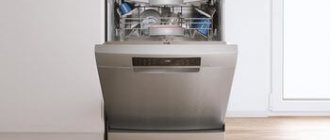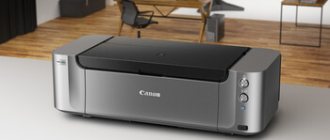A dishwasher can free the user from some of the routine work in the kitchen. It will clean any dishes even from the most stubborn stains, saving time and utility bills.
But a potential buyer is faced with the question of which model to choose so that it meets expectations in terms of cost and performance.
In this article, we have collected the five best dishwasher models for 2021 in terms of price/quality ratio.
The rating, which is based on expert opinions and reviews from real customers, will help you make your final choice.
Rating of the TOP 20 best built-in dishwashers of 2020-2021
| Place | Name | Price |
| TOP 5 built-in dishwashers by price/quality for 2021 | ||
| 1 | Weissgrauff BDW 4543D | Find out the price |
| 2 | Electrolux EEM 923100 L | Find out the price |
| 3 | Weissgrauff BDW 6042 | Find out the price |
| 4 | Electrolux ESL 94200 LO | Find out the price |
| 5 | Bosch SPV25CX01R | Find out the price |
| TOP 5 narrow built-in dishwashers | ||
| 1 | Bosch Serie 2 SPV25DX10R | Find out the price |
| 2 | Electrolux ESL 94585 RO | Find out the price |
| 3 | Bosch Serie 4 SPV45DX10R | Find out the price |
| 4 | Weissgauff BDW 4140 D | Find out the price |
| 5 | Siemens iQ300 SR 635X01 ME | Find out the price |
| TOP 5 full-size built-in dishwashers | ||
| 1 | Weissgauff BDW 6138 D | Find out the price |
| 2 | Hotpoint-Ariston HIC 3B+26 | Find out the price |
| 3 | Midea MID60S100 | Find out the price |
| 4 | Zigmund & Shtain DW139.6005X | Find out the price |
| 5 | Vestfrost VFDW6041 | Find out the price |
| TOP 3 partially built-in dishwashers | ||
| 1 | Siemens SN 536S03 | Find out the price |
| 2 | Bosch Serie 8 SMI88TS00R | Find out the price |
| 3 | Flavia SI 60 ENNA | Find out the price |
| TOP 2 compact built-in dishwashers | ||
| 1 | MAUNFELD MLP-06IM | Find out the price |
| 2 | Flavia CI 55 Havana | Find out the price |
About
Rating of the TOP 20 best built-in dishwashers 60 cm 2021
| Place | Name | Price |
| TOP 4 best built-in dishwashers 60 cm in price/quality ratio for 2021 | ||
| 1 | Weisgauff BDW 6042 | Find out the price |
| 2 | Bosch SMV25EX01R | Find out the price |
| 3 | Zigmund & Shtain DW169.6009X | Find out the price |
| 4 | Electrolux EEA 917100 L | Find out the price |
| TOP 4 best partially built-in dishwashers 60 cm | ||
| 1 | Bosch SMU46AI01S | Find out the price |
| 2 | Kaiser S 60 U 87 XL Em | Find out the price |
| 3 | Bosch SMU24AW01S | Find out the price |
| 4 | Kaiser S 60 U 87 XL ElfEm | Find out the price |
| TOP 3 best built-in dishwashers 60 cm with inverter motor | ||
| 1 | Bosch SMV44KX00R | Find out the price |
| 2 | Hotpoint-Ariston HIC 3B+26 | Find out the price |
| 3 | Bosch SMV25AX01R | Find out the price |
| TOP 3 best built-in dishwashers 60 cm with leak protection | ||
| 1 | Weissgauff BDW 6138 D | Find out the price |
| 2 | Zigmund & Shtain DW129.6009X | Find out the price |
| 3 | Electrolux EEA 927201 L | Find out the price |
| TOP 3 best built-in dishwashers 60 cm with economical program | ||
| 1 | Weissgauff BDW 6043 D | Find out the price |
| 2 | Bosch SMV 25AX00 R | Find out the price |
| 3 | Beko DIN 24310 | Find out the price |
| TOP 3 best inexpensive built-in dishwashers 60 cm | ||
| 1 | Beko DIN 14 W13 | Find out the price |
| 2 | Weissgauff BDW 6062 D | Find out the price |
| 3 | MAUNFELD MLP-12S | Find out the price |
Basic and popular sizes
Built-in dishwashers come in several sizes - small, narrow and full-size. Each model has its own unique parameters.
Small built-in dishwashers have the following dimensions on average:
- width - 45-55 cm;
- height - 45-60 cm;
- depth - 50 cm.
The dimensions of the narrow built-in dishwashers are 82 cm high, 55 deep and 45 wide.
Full-size models typically come in the following sizes:
- width - 60 cm;
- height - 82 cm;
- depth - 55 cm.
The built-in household appliance should be selected according to the parameters of the kitchen cabinet in which the device is planned to be placed.
About
Advantages and disadvantages
The main advantage of built-in dishwashers is their compactness .
Even full-size models fit well into a small kitchen without taking up too much space. At the same time, the capacity of the smallest model is 6-8 sets of dishes.
You can also highlight the following advantages of built-in dishwashers:
- saving time;
- saving resources - water and electricity;
- ease of installation, configuration and use;
- high-quality washing and drying.
It is difficult to highlight the disadvantages of built-in dishwashers, since the model range is so diverse that every buyer can find a household appliance to his taste .
About
Popular manufacturing brands
Bosch built-in dishwashers are especially popular - customers leave mostly positive reviews about this company's household appliances. Each model has a modern, stylish design and wide functionality that ensures the efficiency of its operation.
Siemens built-in dishwashers have many useful features and excellent performance , thanks to which customers are usually completely satisfied with washing and drying dishes.
Electrolux has established itself in the market as a manufacturer of high-quality and efficient built-in dishwashers. Thanks to its advanced functionality and intuitive controls, this company’s household appliances are especially appreciated by customers.
About
The best built-in dishwashers
Miele Miele G 5260 SC Vi
3.6077
Miele G 5260 SC Vi became the leader of our 2021 rating. Its power is 2000 W. This is a model with a small number of modes, whose main disadvantage is the long operating cycle. In the main mode, the Miele G 5260 SC Vi will wash dishes for 194 minutes. In this model, it is also more effective to use the main mode for everything except pots: here the efficiency of the eco mode will be slightly higher - 75% versus 72.5% versus. The price of the model is 90,000 rubles.
How to choose and what to pay attention to?
Before you finally choose a built-in dishwasher, it is very important to pay attention to some basic technical characteristics.
Capacity
The number of place settings that can fit into a dishwasher depends on its dimensions.
Full-size built-in dishwashers, as a rule, can accommodate up to 12-14 sets, compact ones - 6-8 sets.
Cleaning class
Most modern models have a cleaning class, designated by the letter A. This classification is considered an indicator of quality. Such models most effectively clean dishes from various contaminants.
Water consumption
By using a dishwasher, you will still use less water than if you washed dishes in the sink.
Typically, water consumption for one full washing cycle of a full-size built-in model does not exceed 10-12 liters. Thus, the household appliance helps save not only time, but also other resources.
Type of drying
The quality of drying, like the quality of washing, has a letter classification. The best drying class is designated by the letter A. Thus, the device dries the dishes without leaving a single drop.
The dishwasher may be equipped with one of the following drying types:
- condensation drying - dishes dry naturally due to the evaporation of moisture;
- turbo drying - dishes are dried using a fan and heating element;
- intensive drying with a heat exchanger is a combined version of the two previous types of drying.
Operating modes (cleaning)
Built-in dishwashers have a wide functionality, which is represented by a large number of automated programs and temperature modes .
Noise level
Any dishwasher produces some noise during operation. Full-size models tend to be quieter than narrow or compact models.
The optimal level of noise produced is considered to be values in the range of 45-52 dB.
Leak protection
Most models of built-in dishwashers have full or partial protection against leaks. The presence of such a function ensures the safety of using the household appliance.
About
TOP 5 best built-in dishwashers by price/quality for 2021
Weissgrauff BDW 4543D
The first place in the rating is occupied by a narrow built-in model from the manufacturer Weissgrauff . IN
it combines all the necessary functions for excellent results after each washing cycle and is the ideal size for a small kitchen.
But its small dimensions do not prevent this device from washing up to nine sets of dishes.
The controls are electronic, intuitive, and can be used without instructions . All settings are shown on the display. By 2021, high energy efficiency class A began to be marked with advantages. That is, A++, which this model has, consumes electricity much more economically.
In addition, the machine also saves water, consuming about 10 liters per cycle.
The user is provided with 7 washing programs and 7 temperature modes . The delayed start function allows you to start work at any convenient time, not exceeding 24 hours.
The set includes two baskets for dishes, one for cutlery and a holder for glasses.
Safety of operation is guaranteed by complete protection against leaks . In the event of a breakdown, the device will block the water supply.
Specifications:
- type – narrow;
- capacity – up to 9 sets;
- control – electronic, display;
- power – 2100 W;
- noise – 44 dB;
- number of programs – 7 automatic, 7 temperature;
- drying – condensation;
- equipment - protection against leaks, automatic recognition of 3-in-1 products, holder for glasses, basket for cutlery.
pros
- washing quality;
- works quietly;
- large selection of modes;
- ergonomics;
- equipment;
- an excellent solution for a small kitchen;
- affordable price.
Minuses
- uninformative instructions.
Electrolux EEM 923100 L
Two rotating spray arms distribute water evenly into each corner of the cooking chamber.
The dishes will be perfectly clean at any level. The cutlery basket can accommodate even the largest items, such as ladles or spatulas. In total, this model can accommodate up to 10 sets of dishes.
With a power of 1950 W, the machine economically consumes electricity (0.83 kWh) and water (about 10 l).
Equipped with six automatic programs and three temperature ones, including a BIO program, pre-soaking and delayed start.
A beam on the floor will indicate the status of the program, where red indicates that the device is still in operation, and green indicates the end of the cycle.
After completion of work, the door will open slightly by 10 cm, which will allow the dishes to dry completely with natural air circulation.
The salt and rinse aid indicator will indicate their remaining quantity and the need for replenishment. A smart security system will protect you from leaks, which will stop the water supply in the event of an emergency.
Specifications:
- type – narrow;
- capacity – up to 10 sets;
- control – touch;
- power – 1950 W;
- noise – 47 dB;
- number of programs – 6 automatic, 3 temperature;
- drying – condensation;
- equipment - protection against leaks, floor indicator, salt and rinse aid indicator, auto shut-off, cutlery basket.
pros
- high-quality execution of tasks;
- roomy with small dimensions;
- automatic door opening;
- work status beam on the floor;
- build quality;
- price.
Minuses
- The stiffness of the springs in the door cannot be adjusted;
- no glass holder.
Weissgrauff BDW 6042
Full-size built-in model, capable of washing up to 12 sets of dishes, that is, the entire required volume will be clean in one cycle.
But it is not necessary to accumulate a lot of dishes to start the appliance. The half-load function will wash a small amount of dishes without using more electricity or water than necessary.
With a power of 2100 W, this model has a high energy efficiency class A++, and up to 11 liters of water are consumed per cycle.
The timer in 3 hour increments will delay the start of work by 3,6,9 or 12 hours. If desired, the machine will start at night or in the absence of the user.
The controls are electronic and intuitive, making the process of starting the dishwasher easy and fast..
During operation, it is possible to reload dishes in case you forgot to put something in right away. Equipped with four automatic programs and six temperature settings.
The corresponding indication will indicate the need to add salt or rinse aid. The manufacturer has provided complete protection against leaks and the ability to use a 3-in-1 detergent.
Specifications:
- type – full-size;
- capacity – up to 12 sets;
- control – touch;
- power – 2100 W;
- noise – 52 dB;
- number of programs – 4 automatic, 6 temperature;
- drying – condensation;
- equipment - protection against leaks, salt and rinse aid indicator, half load, cutlery basket.
pros
- the dishes are clean, without streaks;
- suitable for large families;
- ease of operation;
- quiet operation;
- economical;
- The kit includes all hoses and informative instructions.
Minuses
- few automatic programs.
Electrolux ESL 94200 LO
The floor-mounted built-in model from the Swedish manufacturer has rightfully earned a place in this rating.
Despite its compact dimensions (width 45 cm), the machine can accommodate up to 9 sets of dishes.
The device has a high class A energy efficiency, washing and drying, a power of 2100 W, and water consumption per cycle does not exceed 10 liters.
The machine is put into operation by setting the necessary programs on the electronic control panel.
The manufacturer has equipped the equipment with five automatic modes, three for temperature setting and condensation drying. In addition, in the intensive mode, which copes with greasy and heavily soiled dishes, the disinfection function comes into play.
The corresponding indication will inform the user with an audible signal when it is necessary to add salt or rinse aid for operation..
As a safety system, AquaControl leakage protection with a double-layer inlet hose with a solenoid valve is provided. In the event of an emergency, the water supply is automatically blocked by the dishwasher.
Specifications:
- type – narrow;
- capacity – up to 9 sets;
- control – electronic;
- power – 2100 W;
- water consumption – 10 l;
- noise – 51 dB;
- number of programs – 5 automatic, 3 temperature;
- drying – condensation;
- equipment - salt and rinse aid indicator, sound signal, leakage protection, glass holder.
pros
- a set of programs for washing dishes;
- quality of washing and drying;
- works quietly;
- easy to operate;
- you can add dishes while working;
- affordable price.
Minuses
- no delayed start;
- Not all trim levels have a cutlery basket.
Bosch SPV25CX01R
As of 2021, the Bosch brand is one of the leaders in the production of household appliances . Bosch
SPV25CX01R is a built-in narrow model, a godsend for a small kitchen and any interior.
Its small size does not prevent it from washing 9 sets of dishes.
Five levels of circulation allow water to penetrate into hard-to-reach places, providing quality washing from all sides.
The equipment independently recognizes the weight of loaded dishes and regulates the amount of water supplied.
Equipped with five automatic modes and three temperature modes, including express washing and pre-soaking. The machine will notify the user about the end of the cycle with a sound signal.
With a power of 2400 W, the device consumes 0.8 kWh of electricity and 8.5 liters of water per cycle, which fully justifies the high energy efficiency class declared by the manufacturer.
Special indicators will tell you when it is necessary to add salt or rinse aid. The working chamber is made of corrosion-resistant stainless steel, and the body is made of impact-resistant plastic.
Specifications:
- type – narrow;
- capacity – up to 9 sets;
- control – electronic;
- power – 2400 W;
- water consumption – 8.5 l;
- noise – 46 dB;
- number of programs – 5 automatic, 3 temperature;
- drying – condensation;
- equipment - salt and rinse aid indicator, sound signal, glass holder, use of 3-in-1 products.
pros
- quality of washing and drying;
- energy efficiency indicators;
- easy installation and operation;
- adjustable sound signal;
- a set of automatic programs;
- high-quality assembly.
Minuses
- no additional loading of dishes;
- no cutlery basket.
About
How to choose a dishwasher: we help you decide on the criteria
Choosing a dishwasher for your home, in our opinion, is a fairly simple task: you don’t need to compare models based on dozens of parameters, and most of these parameters themselves will be simple and intuitive.
However, as in most cases, before you make a choice, you will have to decide whether you need this or that function from among those declared. This will not only minimize the number of specific models from which you need to make a final choice, but it may also help you avoid overpaying for unnecessary options.
As always in our guides to choosing equipment, we try to avoid value judgments and direct advice, preferring instead the option of teaching the user the skills of independent choice. Thus, our task is to tell you what types of dishwashers there are, how they differ and how these differences can affect the operation process.
Type and size
As you know, among kitchen appliances you can most often find widths of 45 and 60 centimeters. Dishwashers are no exception: the vast majority of them are either “narrow” (with a width of 45-50 cm) or “full-size” (with a width of 60 cm). The height of both will be about 85 centimeters, and in most cases it can be adjusted by changing the length of the legs: this will allow you to fix the built-in dishwasher directly under the countertop. The vast majority of dishwashers have a standard depth of 60 cm. The key difference between a full-size and a narrow dishwasher is the number of dishes that can be washed at one time. On average, a narrow dishwasher will fit 9-10 sets of dishes, and a full-size dishwasher will fit up to 16.
Compact dishwashers should be placed in a separate category. They, like their older brothers, can be free-standing or built-in. The height of such a dishwasher will be about 45 centimeters, which can significantly save space. The capacity of compact models is from one to five sets of dishes.
Choosing the type of dishwasher (built-in or freestanding) is usually a matter of taste. Moreover, you can often save money on free-standing equipment - it usually costs a little less. A built-in or partially built-in dishwasher (with an open control panel located on the outside of the door) will require the purchase of an overhead kitchen facade, which will allow it to “fit” into the overall kitchen interior, and a fully built-in dishwasher will completely “hide” among the kitchen cabinets.
The control panel indicates that the dishwasher is not fully built-in
But nothing will give away a fully built-in one when closed - it looks like just another kitchen drawer
But it is better to select the size of the device based on the number of people living in the apartment and based on the preferred scenario for using the dishwasher. Even if there is only one person living in the apartment, the options may be different: some are used to having a couple of plates and washing dishes every day, while others prefer to have a large supply of clean dishes, which allows them to run the dishwasher less often.
Capacity and organization of internal space
Dishwasher manufacturers typically rate their capacity in “sets.” This obvious parameter will tell you how many dishes will fit in the dishwasher at maximum load. The minimum that is presented on the modern market is 4 sets of dishes. Maximum - 17 sets.
A set is a set of cutlery for one person consisting of seven items: a salad plate, a first course plate, a second course plate, a bread plate, a cup or saucer for dessert, two spoons or two forks.
This assessment is convenient because it allows you to compare different models from different manufacturers with each other, but it is quite far from reality: you probably noticed that we are not talking about glasses, mugs, frying pans and pots at all - but in reality they can take up more than 50 % of dishwasher volume.
Small-sized tabletop dishwashers are the simplest: they most often have one retractable basket, into which a separate basket for cutlery is installed.
All others - narrow or wide, freestanding or built-in dishwashers, as a rule, have one of two layouts: classic or modern.
Classic layout: lower basket for large dishes, upper basket for smaller ones. Cutlery is placed in a separate basket, which is installed in the lower basket.
Basket with cutlery
Not so long ago, as an alternative to the classic layout, a variant with three baskets began to be used: lower, middle and upper.
The role of the lower basket has not changed, the upper one is now the middle one, and at the very top there is a horizontal retractable tray, which replaces the basket for cutlery - if they were installed vertically in the basket, they are now placed horizontally on the tray.
Top tray with cutlery
As far as we know, there are no serious studies proving that the modern layout is more effective than the classic one in terms of washing dishes. However, most manufacturers are gradually abandoning the classic layout. In our experience, this is not more efficient, but more convenient - it is easier to arrange cutlery evenly on the tray.
On the other hand, adding another horizontal tray to the design “steals” the height. Some users who changed a dishwasher with a classic layout to a modern one complained that the lower basket previously allowed taller items to be installed.
The middle (upper) basket can be height-adjustable.
Also, in expensive dishwashers in the premium segment, there may be very unusual (but very convenient from the user’s point of view) solutions. For example, a rising lower basket, which allows you to avoid bending down to pick up dishes and when putting them away.
Methods for storing dishes depend on the specific model and the design of its baskets, and, unfortunately, with a quick glance at a dishwasher in a store or on a website, you are unlikely to be able to evaluate (let alone compare) their convenience. Practice shows that in this case, it is more likely that a person adapts to the technology over time, rather than vice versa.
Whether the dishes wash well or poorly depends, among other things, on how correctly they are stacked. Experienced dishwasher owners have been honing this skill for years, and when changing models, they sometimes have to start all over again.
Many models will have holders or separate shelves for fragile glasses, special rubber nozzles for fragile dishes, and similar solutions. It is clear that not all of them will be useful and will find application, however, when choosing a dishwasher, it would not be superfluous to ask how exactly the manufacturer decided to improve your experience of using the device.
Washing
The washing class is a rather difficult category to understand, which is determined using test tests - control washing of specially soiled dishes. If the dishes are perfectly clean, the machine is assigned class A. Class C corresponds to “minor contamination.”
In fact, the vast majority of models on the market are class A or B, and we are far from sure whether the user will be able to distinguish between them in real rather than laboratory conditions.
Almost all dishwashers (except for miniature tabletop ones) are now equipped with three water sprayers - lower, middle and upper. The bottom one is usually the largest. The classic design is a rotating “yoke” with holes from which water flows under pressure.
However, there are also more exotic designs. For example, Electrolux uses this version of the lower spray arm in dishwashers in the middle and high price segments.
At one end of the rotating “rocker arm” there is a ring - and it also rotates
The middle sprinkler is usually a smaller “rocker arm” and is located under the upper (middle) basket.
The top one is located on the ceiling of the washing chamber. At best, this is another “yoke”.
But sometimes, to simplify things, they install a regular spray nozzle.
A spray nozzle instead of a “rocker arm”. But at least it's rotating.
To summarize: in general, the identity of the design most often ensures the identity of the result: most modern dishwashers wash dishes in approximately the same way. There is even an opinion (although we do not have objective evidence of its correctness) that now the efficiency of washing depends more on the correctly chosen product than on the dishwasher.
True, the inquisitive minds of engineers are constantly coming up with something new - well, for example, like the original design of the lower sprinkler mentioned above.
And, of course, if you are a perfectionist, then it is better to have a “rocker arm” on top rather than a nozzle. At least for some reason we only saw injectors in budget models.
Drying
But it will be much easier to understand the drying class: class A means perfectly dry dishes, classes B and C correspond to slightly damp dishes. Note that today it will not be so easy to find dishwashers with drying class C or D - they are quite rare. The drying itself can be carried out by two different methods: condensation or using turbo drying.
Cheaper machines usually use the condensation method, in which the dishes are rinsed with hot water, after which drops of water evaporate, condense on the walls of the chamber and flow down. This process takes quite a lot of time. Expensive dishwashers use turbo drying, which involves blowing warm air over the dishes using a special fan. This method will be faster and more efficient.
Not long ago, a new feature appeared: in dishwashers with condensation drying, at the end of washing, automatically open the door slightly to speed up the drying process. This is a logical and correct idea, therefore, all other things being equal, a dishwasher with this function looks preferable.
Cleaning filters
Every dishwasher has a filter - as a rule, it is located approximately in the middle of the bottom of the washing chamber. From time to time it needs to be removed and manually washed to remove grease and food debris. If you have made a cult of your own laziness or are simply squeamish, it makes sense for you to look for a model with a “self-cleaning” filter - it does not require manual washing.
But to be honest, our built-in skeptic still doesn’t really believe that “self-cleaning” will be as effective as manual cleaning.
Dishwasher products
If you don’t take all the exotic stuff, there are four types of chemicals for household dishwashers: dishwashing detergents, softening salts, rinse aids, and finally - detergents for washing the dishwashers themselves.
Salt is used to soften if you have “hard” water with a high content of calcium salts in your water supply. You can verify this in the simplest way: if you boil tap water in a kettle, look into it. Lots of limescale? This means the water is hard. Not at all? This means there is no need to use salt. As a rule, on the lid of the salt compartment there is a rotating arrow, which, depending on the hardness of the water, should be set to a certain division - this is how the intensity of the supply of salt to the water is regulated. But to find out the hardness of your tap water, you will most likely have to take a sample and take it to a special laboratory. Only very expensive premium dishwashers can determine water hardness and dose salt independently.
Rinse aid
Energy consumption and water consumption
Since we are talking about different classes, it would not be superfluous to mention the energy consumption class. The exact same scale is adopted here, with the exception that the highest class is A++ (modern dishwashers have become much more economical than those models based on the parameters of which the once highest class A was calculated). The higher the class, the less electricity your car will consume.
More understandable for the user is a parameter such as “energy consumption per cycle”, with which you can easily calculate how much electricity the machine will spend, for example, during daily operation for a month.
In addition, the standard water consumption for the standard program is indicated for each machine. Models with water consumption of up to 15 liters per cycle are considered economical; average machines will spend up to 20 liters, which in any case will be less than when washing dishes by hand.
Separately, it should be noted that dishwashers are connected not only to cold, but also to hot water. By using already heated water for washing dishes (the required temperature is obtained by mixing hot water with cold), they can significantly reduce energy consumption. On the other hand, some owners of such machines complain that the dishes are less clean due to the lower quality of hot water in the water supply.
Control and display
Modern dishwashers operate under the control of an electronic system, which includes a set of buttons (mechanical or touch) and, possibly, a display with which the machine will “communicate” with the user. The display usually shows the selected program and the current state of the machine (time until the end of the program, error code in case of malfunction, etc.). It’s hardly worth explaining that machines with a display will be more convenient to use, but also more expensive (compared to models without a display).
Typical control panel of a fully integrated dishwasher
The lack of a display is often compensated by the presence of LED indicators corresponding to various operating modes of the device. They are also, as a rule, responsible for indicating the presence of salt and rinse aid.
It is also worth mentioning that many dishwashers have a special indicator that is projected onto the floor. For built-in dishwashers, it is an indicator beam that allows you to understand when the dishwashing process is complete without opening the door: the beam lights up while the machine is running and goes out (or changes color) when the program completes.
A more advanced display option involves projecting the parameters of the selected program onto the floor (for example, the exact time remaining until the work is completed).
It is also worth paying attention to the presence or absence of built-in lighting. The chamber illumination makes the process of loading and unloading dishes more comfortable.
Programs and features
On the one hand, the presence of special programs can be a decisive factor when choosing a particular dishwasher model. On the other hand, many users do not use all the possibilities provided; I use two or three modes (usually quick/regular/heavy wash).
However, it makes sense to list the most common programs and features that a modern dishwasher can offer.
- Automatic program - the machine itself selects the optimal mode, washing the dishes until it finds them clean. As a rule, the degree of contamination of dishes is automatically determined using a water transparency sensor.
- Bio-program - a program for working with detergents that contain special bio-additives designed to combat fat and protein stains;
- Quick wash - program for washing lightly soiled dishes;
- Intensive washing - a program for heavy soiling. Characterized by increased temperature and increased time. Suitable for pots, pans and dishes with dried food residues:
- Delicate wash - suitable for thin glassware (for example, glasses) that does not withstand high temperatures;
- Economical program - dishes with minor stains can be washed at a temperature of 50-55 °C, which will save up to 20%-25% of energy during the washing process;
- Rinse is a special program designed to lightly rinse dishes placed in the dishwasher without washing them. This is necessary if you plan to start the washing process later, adding more dishes, but are afraid that during this time the already stacked ones may “sour” and give off an unpleasant odor;
- An alternative to the previous option is to start the wash with an underloaded machine. A special “half load” mode can help here.
It is considered good practice to have a delay start timer - this is a standard feature that is present in most modern models. The presence of a timer allows you to start the dishwashing process at a set time, which is especially in demand if you have a two-tariff meter (i.e., reduced cost of electricity at night).
In expensive dishwashers you can also find a function that automatically detects water hardness, which allows you to correctly use softening salt. In models of the cheap and middle segment, the salt consumption is set manually by the user, and the water hardness is asked to be determined independently.
Noise level
For modern dishwashers, the noise level cannot be considered a very critical parameter: they all work quite quietly, and the best models are almost silent. However, if the dishwasher is installed in a kitchen combined with a living room, you may want to give preference to a quieter model.
Leak protection
Finally, the last but not least important point for many is protection against leaks. The prospect of flooding the neighbors makes absolutely no one happy. Like washing machines, the most vulnerable places for leaks are the water supply and drainage hoses, as well as the body of the machine itself.
The machine body is traditionally protected using a pan and a float: if water gets into the pan, the float rises and turns off the system. The hoses are protected by nested “double” hoses and solenoid valves. If water gets into the “external” hose, the protection system is activated and the water supply stops. By the way, such a hose can be installed separately - they are suitable for almost all cars. Having full protection allows you not to worry about potential accidents and calmly set the dishwasher to a delayed start, even if you are not at home.
conclusions
So, let us list once again the sequence of steps when choosing a dishwasher.
- First, we need to decide on the built-in feature and form factor - whether our dishwasher will be wide, narrow, or perhaps even a compact tabletop dishwasher.
- Choose one of the options for organizing the interior space - classic or modern. It depends entirely on your personal ideas about convenience, but if in doubt, we would still suggest a modern option.
- If you are uncompromising in your approach to the quality of washing, take a closer look at the top sprayer: a “rocker arm” is preferable to a nozzle. If you are a supporter of everything new and unknown, a lover of experiments, look for a dishwasher with a lower spray design that is more original than the “rocker arm”.
- If the speed of obtaining clean and dry dishes is important, you will need a dishwasher with a turbo dryer (if not, feel free to take a regular one with convection, this will save quite a significant amount).
- If a dishwasher with convection drying can open the door slightly at the end of washing, this is a useful function; the dishes will dry faster. But, again, the question is whether speed is important to you at all.
- The lazy and squeamish should pay attention to dishwashers with a self-cleaning filter, otherwise it will have to be removed and cleaned manually from time to time.
- Different dishwashers have different energy consumption and water consumption, but, frankly, it is difficult for us to imagine a domestic consumer who would base their choice on these factors. If you are confident in the quality of hot water in the water supply, you can take a closer look at models that connect to hot water - this is a way to really save a lot of energy.
- Ease of control greatly depends on personal preferences, so there are no alternatives to inspection. As a consolation, we can say that we have not yet met a single dishwasher whose controls did not allow washing dishes

- All modern models have regular, intensive, delicate and fast programs. If you want to save energy by using a night tariff, make sure your dishwasher has a delayed start. If you don't start the wash immediately after styling, you will benefit from having a rinse program. If you often need to wash a small number of dishes, make sure that the dishwasher supports the half-load mode.
- Modern dishwashers are, in principle, fairly low-noise units, so if the machine is in the kitchen, then you will most likely be satisfied with any one. If the kitchen is combined with the living room, it is better to choose a particularly quiet one, with a noise level of 45 dB or lower.
- There is no need to skimp on protection against leaks. If it is possible for it to be complete (both the body and the hoses), this is the best option.










